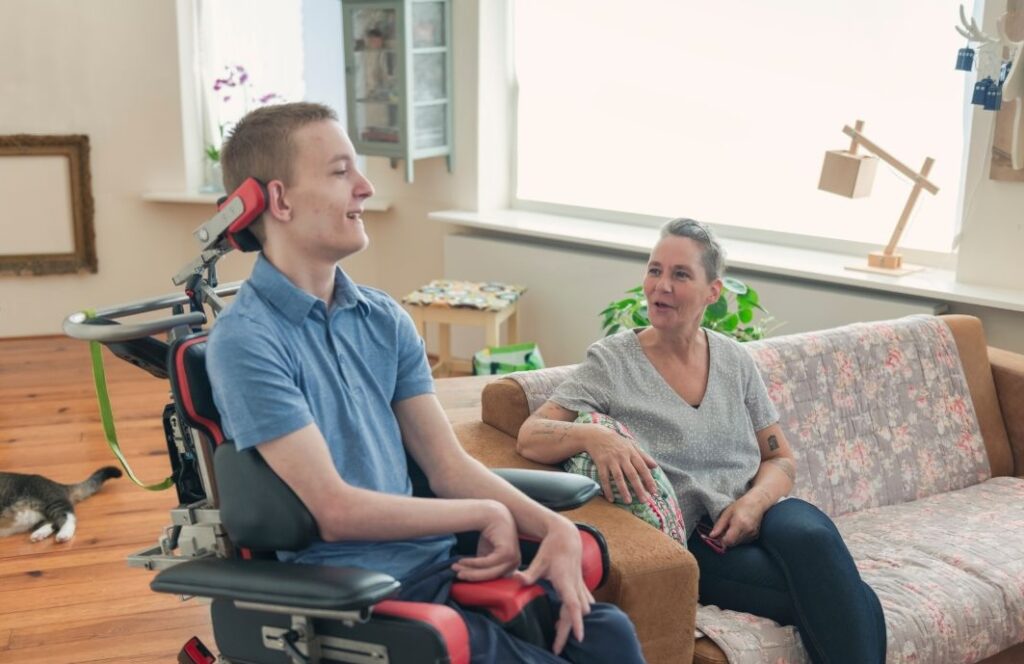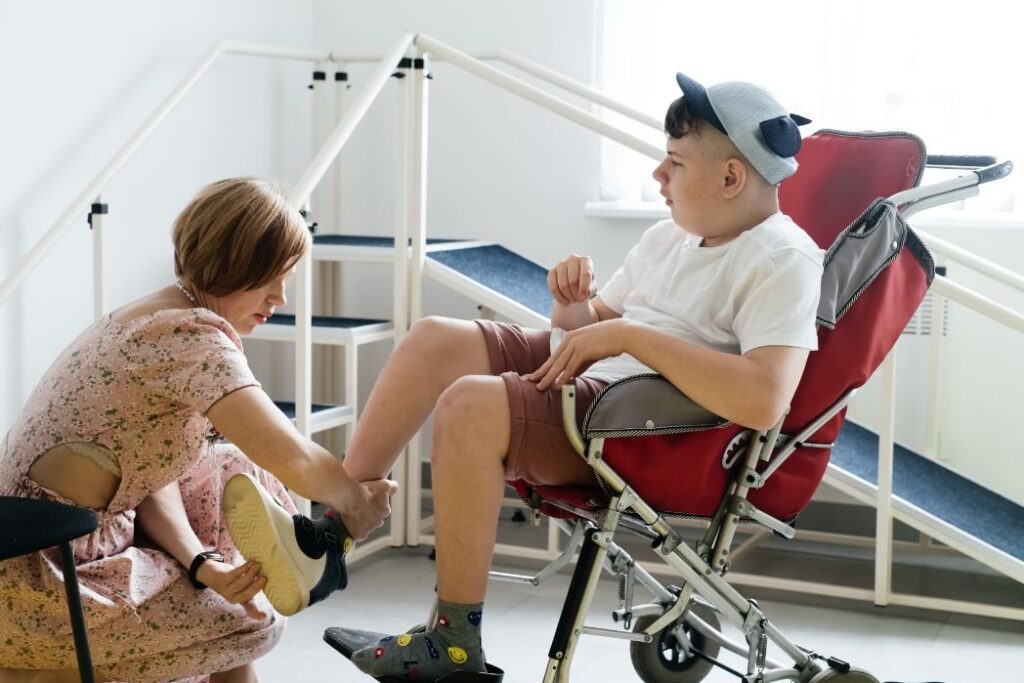Cerebral palsy is a neurological condition that mainly impacts the brain’s control over movement. Someone with cerebral palsy may have a wide range of physical and mental health conditions.
How severe the symptoms are will vary from person to person, determining the treatment they need; however, most individuals with cerebral palsy require assistance with everyday tasks, personal care, and emotional support, which can be given through cerebral palsy home care.
Since cerebral palsy is a lifelong condition, individuals must have access to 24/7 assistance to enable them to live as independently as possible. Live-in carers who specialise in cerebral palsy are on hand to give care and support as and when required, alleviating tasks and providing companionship.
Types of Cerebral Palsy

Cerebral palsy is the most common childhood disability, and it affects thousands of people around the world. The condition can occur before birth, during delivery, or within a few years of an individual’s life.
When it comes to the symptoms of cerebral palsy, as mentioned, they will usually vary but could include the following:
- Muscle stiffness.
- Lack of coordination.
- Balance issues.
- Seizures.
- Speech problems.
- Gastrointestinal symptoms, i.e. swallowing, abdominal pain, and constipation.
As you can see from just this short list, cerebral palsy is a condition that makes day-to-day life challenging.
There are five types of cerebral palsy; below is a detailed look at three main types.
Spastic Cerebral Palsy
Spastic cerebral palsy is the most common variation of cerebral palsy, and it generally means the person with it has stiff muscles and joints and irregular movements.
Movement – particularly walking – is a challenge, as well as other tasks that most people would take for granted, such as cooking, doing laundry, or tidying up around the house.
The stiffness can occur on one side, or it might be contained in one area, such as the arms or legs (sometimes just one arm or leg), so in some cases, it won’t be as severe as in others.
As well as movement issues, some people with this type of cerebral palsy may also be diagnosed with neurological conditions, including ADHD.
Ataxic Cerebral Palsy
Individuals with ataxic cerebral palsy often have problems with balance and coordination, resulting in unsteady movements and a lack of control over their fine motor skills.
Writing, buttoning clothes, or using utensils may be challenging.
Another issue with this particular type of cerebral palsy is muscle tone – it can become loose (known as hypotonic), or it might tighten (spastic).
Mixed Type Cerebral Palsy
As the name suggests, anyone with mixed cerebral palsy will have symptoms that link to more than one type of the condition, and that means that both fine motor skills and general coordination can be affected at once.
The type of cerebral palsy and severity of the symptoms depend on the area of the brain that’s specifically affected. Hence, a personal and comprehensive approach is crucial to track and manage the condition.
Caring Considerations for Adults with Cerebral Palsy

Navigating the transition from childhood to adulthood with cerebral palsy is a nuanced experience for both individuals and their carers.
As individuals with cerebral palsy grow older, parents may notice heightened developmental delays or mental health considerations. However, adulthood also brings its share of victories, such as achieving personal goals or newfound independence like walking unassisted.
The level of self-sufficiency varies widely among adults with cerebral palsy. Some, with milder forms, may live independently and work full-time, while others, dealing with more severe forms or additional conditions, may require ongoing assistance.
With no cure for cerebral palsy, consistent access to healthcare and support services is crucial for enhancing the quality of life for these individuals. Ultimately, individuals with cerebral palsy can live full lives with the right kind of care.
Let’s see what caring for adults with cerebral palsy looks like.
Physical Health
When a loved one navigates life with specific accessibility and mobility needs, it becomes imperative to consider adapting living spaces accordingly. This might involve making room for assistive devices and medical equipment, transforming the environment into one that seamlessly supports the individual’s unique requirements.
Caring for an individual with cerebral palsy involves coordinating healthcare management to safeguard their overall well-being. This includes not only facilitating regular medical check-ups but also actively engaging in the management of physical therapy routines.
Additionally, assisting with daily activities is vital to creating a conducive and supportive environment for the individual’s sustained physical health.
Balancing these considerations requires a thoughtful and adaptive approach, ensuring that the living space and healthcare routines are harmoniously aligned to enhance the quality of life for individuals in need.
Communication Ability
Supporting a loved one effectively involves recognising the importance of communication in daily life.
Patience and understanding are critical virtues as you adapt to the individual’s unique communication style, including non-verbal cues or assistive technology. You may need to learn to interpret gestures and facial expressions or utilise devices that facilitate communication.
It’s a journey that requires openness and a willingness to embrace diverse forms of expression. By acknowledging and respecting the individual’s preferred means of communication, you can foster a deeper connection.
Emotional and Psychological Well-Being
When supporting a loved one with unique challenges, friends and family must actively include them in social activities. This means having them around and making sure they’re genuinely part of the action.
The goal is to combat any sense of isolation, whether it’s inclusive gatherings or activities tailored to their interests. At the same time, it’s essential to keep an eye out for potential mental health challenges.
Providing straightforward emotional support is crucial, creating an environment where individuals feel comfortable expressing themselves.
Recognising the importance of mental well-being, you should also help connect the individual with mental health professionals when necessary.
Financial Considerations
As with any long-term health condition, there are financial considerations.
There are government assistance programmes that can help with the cost of live-in care – explore these and see what you can apply for to ensure your loved one gets the care they need.
An individual with cerebral palsy may be able to work to promote financial independence; therefore, it’s wise to look into their income potential, as this could be extremely helpful, especially if they also need 24/7 support.
When it comes to this support, there are various levels to choose from. Live-in carers can offer 24/7 support, whether temporarily or permanently, helping support the individual’s well-being now and in the future.
Ways to Provide Effective Care for Adults with Cerebral Palsy
As mentioned, one of the best ways to offer effective care for adults with cerebral palsy is with a live-in carer. Here’s how they can help.
Personalised Care Plans
A live-in carer plays a pivotal role in the comprehensive care of adults with cerebral palsy by conducting a meticulous assessment that considers their distinct needs, preferences, and daily routines.
The flexibility in the care plan ensures that the assistance provided remains responsive, aligning with the individual’s dynamic health and well-being requirements over time.
Adaptive Equipment
A live-in carer proactively identifies and implements essential adaptive equipment to optimise the mobility, independence, and overall comfort of the individual under their care.
Identifying necessary adaptive equipment may encompass a range of solutions, from mobility aids like walkers or wheelchairs to customised seating arrangements that provide ergonomic support.
Physical Therapy
A live-in carer actively collaborates with healthcare professionals to integrate prescribed physical therapy exercises into the daily routine of the individual with cerebral palsy.
These exercises are carefully designed to enhance muscle strength, flexibility, and overall physical well-being.
Nutrition and Meal Planning
In addition to providing attentive care, a live-in carer undertakes a comprehensive approach to the individual’s well-being by conducting a dietary assessment.
This assessment delves into the nuances of the individual’s nutritional needs and preferences, forming the basis for a customised and well-balanced meal plan.
A live-in carer can extend their support to various daily tasks, including cleaning, tidying, and personal hygiene.
Emotional and Social Support
A live-in carer is a crucial source of companionship and emotional support, prioritising the mental well-being of the individual under their care.
Actively engaging in conversations and recreational activities and fostering social interactions, the carer combats feelings of isolation that individuals with cerebral palsy may face.
They can also actively facilitate social interactions by organising and accompanying the individual to social events, contributing to developing a sense of community and preventing social isolation.
If you are an unpaid carer to a family member or friend with cerebral palsy, a live-in carer can provide respite, giving specialised care to the individual as and when required. Consider IP Live-in Care; contact our team for personalised advice.
